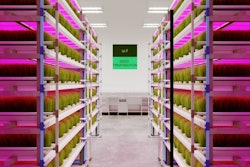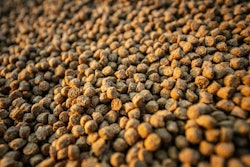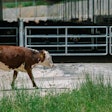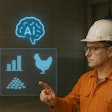Secure data sharing innovation adds value and transparency across ag supply chain
Blockchain may be the solution to tracing the entire food system from end to end. Originally developed in the 1990s as a tamper-proof system for timestamping documents, it didn’t have a real-world application until peer-to-peer cryptocurrency was launched in 2009.
The most common application for blockchain is a transaction ledger, but any information can be stored on a blockchain and exploration of applications outside cryptocurrency are numerous. After the highly publicized rise of Bitcoin, the world’s leading commodities and food companies noticed blockchain’s potential for the food sector.
Although groundbreaking, the technology is relatively simple. Blockchain is a shared database that stores information in blocks with fixed storage capacities and links them together via cryptography, or code. As new data becomes available, a new block is formed and becomes chained to the previous block in chronological order.
Blockchain can be used to record supply chain data such as field of origin, ingredient expiration dates, food safety assurance and carbon footprint measurements.
Blockchain platforms may one day communicate the complete story of meat, poultry, dairy, produce and packaged foods to consumers, who increasingly care where their food and its ingredients come from.
“There are good reasons to adopt blockchain, or any technology, for digitalizing the upstream or downstream supply chain of agricultural commodities,” said Petya Sechanova, CEO of grain shipping platform Covantis. “There are already such applications existing today for field level data mapping, crop data, traceability, sustainability, warehouse receipts and order payments.”
While still in early stages, today’s applications in the food and agriculture sectors indicate end-to-end supply chain transparency may be achieved soon through expansion of blockchain platforms and users.
Blockchain application inspires transformative partnership
Global grain trading remained relatively unchanged for a century until the world’s top commodities traders — ADM, Bunge, Cargill, COFCO, Louis Dreyfus Co. and Viterra — came together to digitalize the process.
Shipping without standardized digital processes causes challenges, such as:
- Inefficiency and risk of errors — Slow and erroneous communication through the supply chain due to information opacity. Difficulty tracking the status of documents and cargo at all stages.
- High working capital and risk of penalties — Document delays before discharge, demurrage risk, LOI (letter of indemnity), delayed documents presentation and delayed payments.
- Security — No single source of truth, lack of audit trail, information exchanged via insecure channels, increased possibility of forged documents.
In order to make shipping more secure, efficient and simple, a joint initiative was formed in 2019 with the goal of developing a blockchain platform. One year later, the Covantis initiative was incorporated as an independent legal entity in Geneva, Switzerland.
Covantis partnered with providers ConsenSys, Microsoft Azure Cloud and Cognizant, leveraging the top technology solutions and offerings to modernize global trade operations for agricultural commodities.
“Blockchain is specifically useful to address the challenges around the lack of audit or single source of truth, security — especially in a low-trust environment and for digital networks bringing together multiple actors who are both counterparties but also competitors,” Sechanova said.
The high security of blockchain minimizes operating risks while increasing market efficiency for the agricultural trading and shipping industry.
“With the use of standard and reliable encryption algorithms, the platform ensures the confidentiality of transactional data as well as the non-repudiation of messages and nominations,” Sechanova said. “Covantis access controls ensure that platform participant users can only access information related to their data and the interactions with other platform participants. Additionally, all user accounts are protected with two-factor authentication.”
The platform’s initial scope covered the shipment and execution of bulk corn and soybeans to anywhere in the world from Brazil, and later expanded into other markets. In early 2022, Covantis’ platform added the shipment and execution of all major grains and oilseeds commodities from U.S. and Canada to anywhere in the world.
“We are planning expansion to other major exporting countries, such as Argentina, and other commodities, like sugar, and more destinations,” Sechanova said. “We are also increasing our network of companies, commodity traders and producers that use Covantis. With the feedback from the market, we are continuously expanding and enhancing our product scope to ensure that we work on the things that matter the most.”
Using blockchain makes doing business for international commodities trading partners more efficient, less risky and less costly.
Petya Sechanova, CEO of Covantis (Courtesy Covantis)
Blockchain enhances safety for foodservice industry
On the other end of the supply chain, food retailers and the foodservice industry have embraced blockchain for its ability to enhance supply chain management and empower consumers to make informed decisions about the food they eat.
The FoodLogiQ platform was developed to track millions of data points daily, enabling supplier management, food safety compliance, quality incident management, recall management and whole chain traceability on a single platform.
Companies on the platform build a blockchain network that allows its participants to transfer data between each other by submitting transactions. Each transaction is recorded in an immutable ledger within the blockchain.
Customers can share any data in the blockchain from critical tracking events for farm-to-fork traceability or documents associated with their suppliers.
It connects thousands of food companies around the world, as well as hundreds of growers, co-packers and produce marketers. FoodLogiQ customers include retailer Whole Foods Market; restaurants Buffalo Wild Wings, Chipotle Mexican Grill, Five Guys Burgers and Fries, and Subway; and food manufacturers Hain-Celestial and Seal the Seasons.
Dean Wiltse, FoodLogiQ’s CEO, said connecting its customer data gathered in the platform with other platforms that serve the food industry will provide a level of supply chain visibility the industry has never seen before.
Future implications for animal feed production
As a critical component of the animal production supply chain, feed mills of the future may exchange data with suppliers upstream and downstream using blockchain platforms. For example:
- Ingredient carbon footprint measurements
- Grain quality characteristics
- Temperature cable and sensor readings
- Ingredient and feed recall information
- Feed inventory levels
- Food Safety Modernization Act (FSMA) compliance
- Feed delivery transactions
- Order and payment receipts
Looking ahead, blockchain has the potential to dominate the digitization of supply chain traceability, however, Sechanova said it will take time for end-to-end integration in agriculture.
“I certainly hope it will take less than 15 years, [but blockchain] is still in an early stage of its lifecycle,” Sechanova said. “Change management takes time in terms of network buildup, adoption, mindset about a different way of working, and people’s agility and savviness using new digital tools.”
The security and transparency that blockchain transactions provide offers abundant opportunities for digitally tracing food ingredients throughout the supply chain, enhancing the value and safety for all food industry stakeholders from end to end.
Announcing the Feed Mill of the Future digital supplement
WATT’s feed brands Feed Strategy and Feed & Grain magazines join forces to launch the monthly Feed Mill of the Future digital supplement. Each edition aims to provide animal feed industry stakeholders with forward-looking content, market insights and a spotlight on the leading-edge technologies shaping the global feed industry of tomorrow.
Subscribe today! https://bit.ly/3dWzow7
















